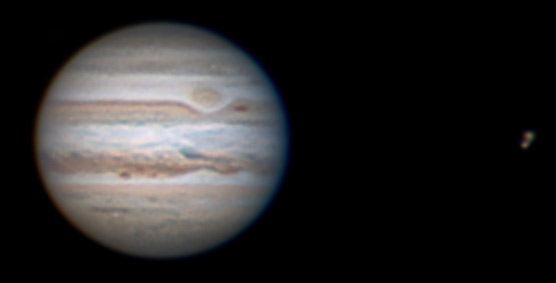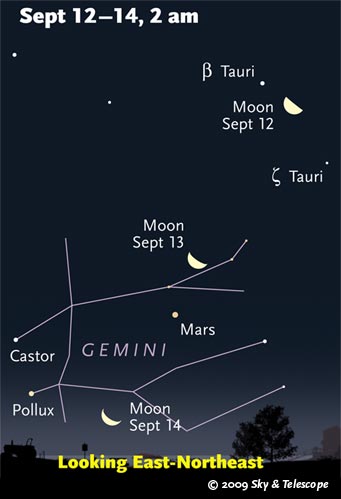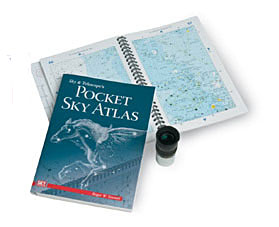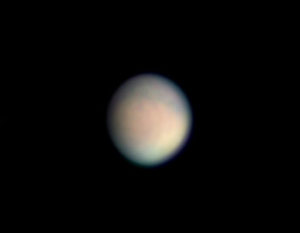Some daily events in the changing sky for September 4 – 12.
Friday, Sept. 4

This year, Jupiter's Great Red Spot has been nicely bordered by the thick white line of the Red Spot Hollow, which indents the dark South Equatorial Belt. Note the very dark red barge following behind the pale Red Spot. The North Equatorial Belt is full of turbulence, including a big blue plume. Far to the right (celestial east), Ganymede and Europa are in conjunction. S&T's Sean Walker took this image at 1:15 UT September 3, 2009. South is up. Stacked-video images like this show much more detail than you're ever likely to see visually on Jupiter.
For all of the Red Spot's central-meridian crossing times, good worldwide, use our Red Spot calculator, or print out our list for the rest of 2009.
S&T: Sean Walker
Saturday, Sept. 5
Sunday, Sept. 6
Monday, Sept. 7
Tuesday, Sept. 8
Wednesday, Sept. 9
Thursday, Sept. 10

Mars and the waning Moon shine in the early-morning hours. (These scenes are drawn for the middle of North America. European observers: move each Moon symbol a quarter of the way toward the one for the previous date.)
Sky & Telescope diagram
Friday, Sept. 11
Saturday, Sept. 12
Want to become a better amateur astronomer? Learn your way around the constellations. They're the key to locating everything fainter and deeper to hunt with binoculars or a telescope. For an easy-to-use constellation guide covering the whole evening sky, use the big monthly map in each issue of Sky & Telescope, the essential magazine of astronomy. Or download our free Getting Started in Astronomy booklet (which only has bimonthly maps).

The Pocket Sky Atlas plots 30,796 stars to magnitude 7.6 — which may sound like a lot, but that's less than one star in an entire telescopic field of view, on average. By comparison, Sky Atlas 2000.0 plots 81,312 stars to magnitude 8.5, typically one or two stars per telescopic field. Both atlases include many hundreds of deep-sky targets — galaxies, star clusters, and nebulae — to hunt among the stars.
Sky & Telescope
Once you get a telescope, to put it to good use you'll need a detailed, large-scale sky atlas (set of charts; the standards are Sky Atlas 2000.0 or the smaller Pocket Sky Atlas) and good deep-sky guidebooks (such as Sky Atlas 2000.0 Companion by Strong and Sinnott, the more detailed and descriptive Night Sky Observer's Guide by Kepple and Sanner, or the classic Burnham's Celestial Handbook). Read how to use them effectively.
Can a computerized telescope take their place? I don't think so — not for beginners, anyway, and especially not on mounts that are less than top-quality mechanically. As Terence Dickinson and Alan Dyer say in their Backyard Astronomer's Guide, "A full appreciation of the universe cannot come without developing the skills to find things in the sky and understanding how the sky works. This knowledge comes only by spending time under the stars with star maps in hand and a curious mind." Without these, "the sky never becomes a friendly place."
More beginners' tips: "How to Start Right in Astronomy".
This Week's Planet Roundup

It's starting to be Mars season again — barely. The planet is high in the morning sky but only 6 arcseconds wide. Nevertheless, S&T's Sean Walker managed to record some surface detail on the morning of September 2nd. The dark area at top includes Mare Sirenum and Mare Cimmerium. The small spot just upper left of center is Phoenicis Lacus. Note the north polar haze. South is up. Walker used a 12.5-inch reflector and IRGB color filters for this stacked-video image.
S&T: Sean Walker
Mercury is lost in the sunset.
Venus (magnitude –3.9, in Cancer) blazes in the east before and during dawn.
Mars (magnitude +1.0, in the feet of Gemini) rises around 1 a.m. and is high in the east before dawn. In a telescope it's still only 6 arcseconds wide: a tiny, fuzzy blob. Mars is on its way to an unremarkable opposition late next January, when it will grow no larger than 14 arcseconds wide.
Jupiter (magnitude –2.8, in Capricornus) comes into view in the southeast as twilight fades — the first "star" to appear after sunset. It's higher in better telescopic view by 10 p.m. Jupiter's recent impact mark had faded from view; see our article.
Saturn is hidden deep in the sunset. Too bad; on September 4th its rings turned edge-on to Earth.

Watch the impact mark spread and grow over the course of four weeks! It's the dark mark near the pole at the 2 o'clock position. Theo Ramakers writes, "Here is an updated animation containing the images of a large number of dedicated Jupiter imagers, members of the ALPO Jupiter listserve. Hans Joerg Mettig from Jupos.com in Germany converted the submitted images to a polar projection, and I put them together in an animation."
Notice the rather that just spreading out, the original impact site seems to keep pouring out black stuff that then drifts away.
Theo Ramakers
Uranus (magnitude 5.7, just below the Circlet of Pisces) is well up in the southeast by 10 p.m.
Neptune (magnitude 7.8, in Capricornus) appears 5° or 6° east of Jupiter — and nearly 20,000 times fainter. See our finder charts for Uranus and Neptune.
Pluto (14th magnitude, in northwestern Sagittarius) is still well up in the south-southwest right after dark. See the finder chart in the June Sky & Telescope, page 53. Good luck.
All descriptions that relate to your horizon or zenith — including the words up, down, right, and left — are written for the world's mid-northern latitudes. Descriptions that also depend on longitude (mainly Moon positions) are for North America. Eastern Daylight Time (EDT) equals Universal Time (also known as UT, UTC, or GMT) minus 4 hours.
To be sure to get the current Sky at a Glance, bookmark this URL:
http://SkyandTelescope.com/observing/ataglance?1=1
If pictures fail to load, refresh the page. If they still fail to load, change the 1 at the end of the URL to any other character and try again.
 0
0
Comments
You must be logged in to post a comment.